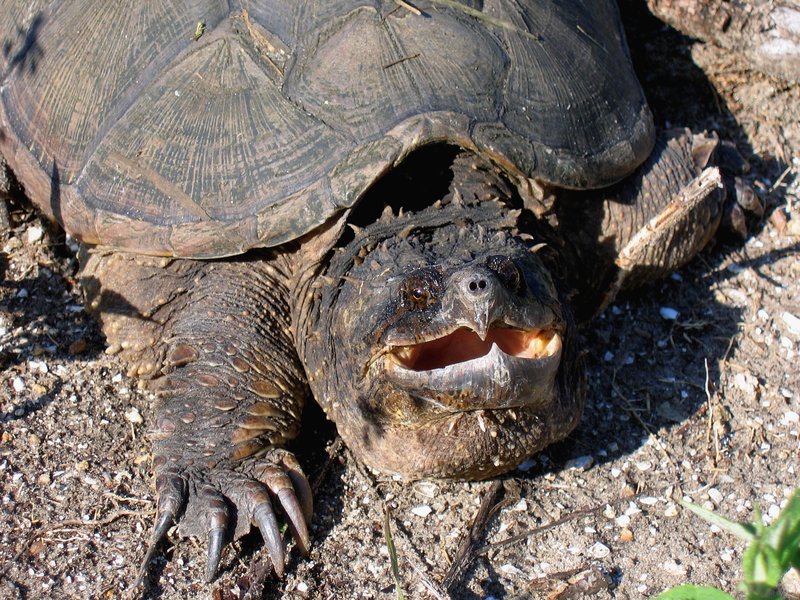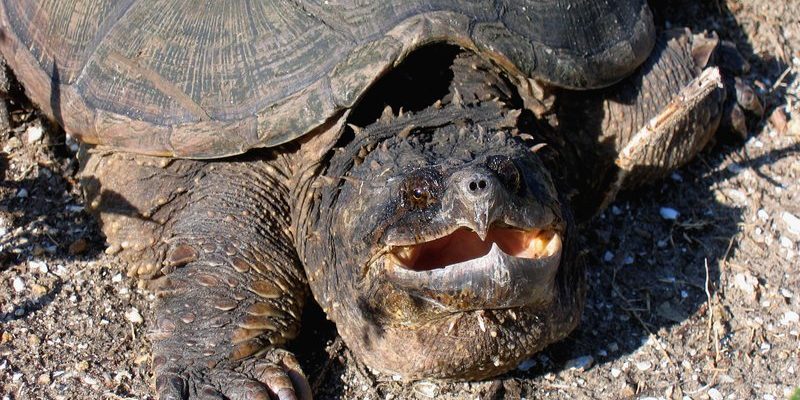
These turtles belong to the family Chelydridae, and they can be found in freshwater habitats across North America. With their strong jaws and distinctive shells, snapping turtles are a unique part of our ecosystem. From their interesting lifespans to their remarkable hunting techniques, there’s much more to these turtles than meets the eye. Now, let’s explore some captivating facts about these tough reptiles!
1. They Can Weigh Over 200 Pounds
You might be surprised to learn that snapping turtles can grow to enormous sizes. The common snapping turtle (Chelydra serpentina) can weigh between 10 to 200 pounds, making it one of the largest freshwater turtles in North America. Some exceptional individuals have even been recorded at weights nearing 300 pounds!
Imagine trying to lift a hefty bag of dog food—that’s about the weight of a larger snapping turtle. Their size can be intimidating, but it’s fascinating to see how they move in the water. You’d think their bulk would slow them down, but they can swim surprisingly well, using their powerful legs and feet to propel themselves through their aquatic homes.
2. They Have Powerful Jaws
Snapping turtles are known for their incredibly strong jaws. They have a bite force of over 1,000 pounds per square inch! That’s similar to the bite force of some large carnivorous mammals. Honestly, if you’ve ever seen a snapping turtle in action, you’d know not to underestimate them.
Their jaws are designed for fishing and scavenging. They don’t have the flexible beaks that many other turtles possess, which means they can snap down on their prey quite fiercely. Their diet mainly consists of fish, frogs, and even small mammals. Imagine being a fish swimming peacefully, only to encounter the sudden appearance of a snapping turtle with an appetite!
3. They Can Be Quite Grumpy
Snapping turtles have a bit of a reputation for being feisty. If they feel threatened, they’re not afraid to bite or snap at anything that comes too close. It’s like they’re saying, “Back off, I can take care of myself!”
This behavior comes from their need to protect themselves. Although they don’t actively seek out trouble, a cornered snapping turtle will defend itself fiercely. If you ever encounter one in the wild, it’s best to observe from a distance. Some people might even mistake their aggressive behavior for being mean-spirited, but really, they’re just being cautious.
4. They Can Live for Over 100 Years
When it comes to longevity, snapping turtles take the crown. These reptiles can live for over a century, with some living well past 100 years. That’s like having a pet that could be around for your entire lifetime!
Their long lifespan makes them an interesting part of the ecosystem. They reach sexual maturity relatively late, usually around 10 to 20 years old, which is another reason why protecting existing populations is so important. If you’re lucky enough to see a snapping turtle in the wild, you’re likely looking at a creature that has seen many seasons change throughout its life.
5. Their Shells Aren’t Always Hard
While snapping turtles do have hard shells, did you know that their shells can also be flexible? The upper shell, or carapace, is sturdy, but the bottom shell, or plastron, has some give. This flexibility is helpful when the turtle needs to maneuver through tight spaces or when it’s diving underwater.
You might be surprised to discover that snapping turtles can often be found basking in the sun, hiding amongst rocks and logs, or even in shallow water. Their ability to blend into their environment is one of their secret survival tactics. It’s like they’re wearing a natural camouflage, helping them evade predators.
6. They Breathe Through Their Butts
Okay, this might sound a little silly, but it’s true! Snapping turtles have a unique ability to absorb oxygen through their cloaca, which is essentially their rear end. This process is called cloacal respiration.
Imagine trying to breathe while relaxing in a hot tub! That’s kind of how snapping turtles manage to stay submerged for long periods. They can actually hold their breath for several hours when they’re not using their cloaca to breathe. This nifty trick allows them to stay submerged and safe from predators while hunting or resting.
7. They Are Excellent Hunters
Snapping turtles are remarkable hunters, using their patience and stealth to catch prey. They often sit still at the bottom of lakes or rivers, waiting for fish or frogs to come close. It’s almost like they’re playing a game of hide and seek, except they play to win!
When they’re ready to strike, they launch themselves forward with impressive speed, snapping up their meal. This hunting technique is so effective that it has given them a reputation as fierce predators in their habitat. You might think of them as the underwater equivalent of a great white shark—patient, powerful, and efficient.
8. They Play a Role in Their Ecosystem
Snapping turtles are vital to their aquatic ecosystems. As both predators and scavengers, they help maintain a healthy balance in their environments. By keeping populations of fish and amphibians in check, they contribute to the overall health of their habitats.
When snapping turtles scavenge, they consume dead animals, helping to clean up their environments. Think of them as nature’s clean-up crew! Their role is essential for ensuring that ecosystems continue to thrive. Without snapping turtles, our freshwater habitats would look very different.
9. They Can Be Found All Over North America
Snapping turtles are quite adaptable and can be found in various habitats throughout North America. From ponds and lakes to rivers and marshes, they thrive in freshwater environments. They typically prefer shallow waters, where they can dive down or bask in the sun.
Their widespread presence makes them a familiar sight for those who enjoy outdoor adventures. You might be wondering where you can spot them; just look near slow-moving water bodies. However, keep a respectful distance—remember, they can be a bit cranky!
10. They Can’t Retract Their Heads
Unlike many other turtles, snapping turtles can’t pull their heads into their shells for protection. Instead, they have long necks that allow them to snap quickly. When they feel threatened, they rely on their powerful jaws and quick movements instead of hiding.
This distinct feature makes them unique among turtles. It also means that they have to be more aware of their surroundings. While some turtles can retreat into their shells, snapping turtles take a more aggressive approach to safety—sort of like a soldier standing their ground.
In conclusion, snapping turtles are more than just tough reptiles; they’re essential parts of the ecosystem, fascinating hunters, and ancient survivors. The next time you hear about one or see a snapping turtle on your outdoor adventures, you’ll appreciate how intriguing they truly are! Whether they’re basking in the sun or lurking beneath the water, these turtles deserve our respect and protection.

